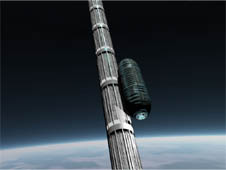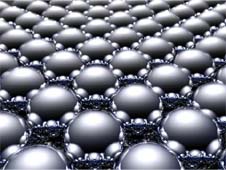Nanotechnology
Objects once measured in meters have become so small that they
cannot be seen by the naked eye, with revolutionary applications across
the board. Gentlemen, forget what your courtesans have told you: size
does matter!
- Morgan Industries Annual Report (Sid Meier's Alpha Centauri)
Nanotechnology, the ability to build machines on the molecular scale, has a potential rivalling Higgs field technology. By using self-replicating nanomachines almost anything could be built with atomic precision out of the component atoms (which can easily be obtained from the environment with no need for mining or complex extraction processes), and since they are self-replicating the price could become nearly arbitrarily low while the scale of operations could range from the microscopic to transforming entire planets. Nanocomputers would be smaller than bacteria, controlling nanodevices that could do anything from acting as a technological immune defence to subtle intelligent weapons. The potential is at least as big as that of living organisms in producing objects and transforming the environment, and likely much larger.
Unfortunately nanotechnology has proven to be more elusive than expected in the 20th and 21st century; various technological complications have hindered development. On many of the colonies few or no attempts were even made given the discouraging experiences back on Earth, and several colonies (like Nova and New America) spent decades pursuing limited approaches. The first real success outside the solar system was made on Atlantis in 2305 when the Nanoscale Collective managed to get a primitive nanoassembler up and running. Since then much capital has been invested into the NC and related businesses. The technology has developed to the extent that it is partially useful. The builder nanodevices are fragile and do not survive outside very controlled high vacuum laboratory conditions, and due to limitations of the replication and control process they can mostly produce arbitrary amounts of chemicals or blocks of matter with a molecular texture. Even this very limited technology has revolutionised many areas: chemical industries have begun to move into orbit to take advantage of the conditions or miniaturise their production processes into smaller nano-supported modules that can be sold. New materials such as bulk diamond, ultra-strong fibres, extreme low-density aerogels, "smart" microspheres containing other chemicals that will release them under certain conditions and "smart" materials with weird properties. Atlantean investors are confident that the technology can be developed much further.
Mymach Inc. Personal Drug Manufacturer, "Pocket Pharmacopoeia™
One of the first mass market nanotech products, a portable drug manufacturing device. Using a system of nanoassemblers the device can produce just about any molecule given the right nutrients, it just needs a program to put together the molecules atom by atom. The whole device is 10x10x5 centimetres large and connects to standard Atlantean computers. It comes with a number of pre-programmed drugs such as public domain painkillers, hormones and recreational drugs; new designs can be downloaded from the Net for a fee. The device can produce one capsule in around 2 minutes, and have internal stores enough to make up to a 100 doses before it needs a nutrient refill.
Nandex™
An "active fabric" composed of micromachines built using nanotechnology by Genius Materials. The micromachines link together when commanded and can form a opalescent, flexible fabric that can be commanded to become different kinds of clothing that can be animated, made to reform, change colouring or size. After use the clothing dissolves into a liquid of micromachines again until next use. It is very expensive at present, making it a definite style statement. However, not all software bugs have been ironed out, which can be quite embarrassing…
Polyful™
 A
nanotube/ polybuckminsterfullerene composite manufactured mainly for the
Beanstalk project but also finding new uses elsewhere. Polyful™
has a tensile strength close to the theoretical limits of molecular matter;
a single one millimetre strand can easily support many tons. The most
impressive property is that it is self-healing: if the nanotubes inside
a Polyful filament are broken, fullerene from the matrix heals them only
causing a slight lengthening.
A
nanotube/ polybuckminsterfullerene composite manufactured mainly for the
Beanstalk project but also finding new uses elsewhere. Polyful™
has a tensile strength close to the theoretical limits of molecular matter;
a single one millimetre strand can easily support many tons. The most
impressive property is that it is self-healing: if the nanotubes inside
a Polyful filament are broken, fullerene from the matrix heals them only
causing a slight lengthening.
Diapad™
A protection/encapsulation substance made by Kelvin Chemists. Unlike other diamond layers used to harden and protect objects diapad forms a thick shell around the object. Objects are simply dipped into the Diapad solution and an activator chemical added. The Diapad accretes on the surface, forming a meshwork of diamondoid nanodevices that is nearly as tough as ruby. The colour depends on the model; currently Kelvin Chemists markets it only as opaque black or semi-transparent, but a whole spectrum of colours (and patterns) are in development. The Diapad can only be removed by adding a "key" chemical (unique to each individual dose Diapad) which causes the nanodevices to break loose from each other, transforming the padding into dust over the span of an hour. Diapad has been promoted as the ideal way of sealing in sensitive materials, as protection during space travel as well as a novelty toy for the Atlantean market.
